 I have got a lot of powder on hand. Kept with controlled temperature and humidity, and only one container of one type open at any given time, I’ve not had the misfortune of soured powder smells or degraded performance. For my personal use, I’ve arrived at best recipes in various long standing component combinations, finding the most recent glut of powder introductions offering little more than niche benefits. I think, for most handloaders, components represent a longer term investment, always to be found as ammunition shortages come and go and prices soar to feed a corporate bottom line.
I have got a lot of powder on hand. Kept with controlled temperature and humidity, and only one container of one type open at any given time, I’ve not had the misfortune of soured powder smells or degraded performance. For my personal use, I’ve arrived at best recipes in various long standing component combinations, finding the most recent glut of powder introductions offering little more than niche benefits. I think, for most handloaders, components represent a longer term investment, always to be found as ammunition shortages come and go and prices soar to feed a corporate bottom line.
No, I do not begrudge corporate profit taking. That is a legitimate strategy that has always been alive in business. However, business is not my poor relative that I must support for the greater good, so it is OK for me to have profit countering strategy and pound containers of powder with $10.99 price tags amongst those price marked $28.00. In the end, the chronograph made the choices.
An all Maine bullet line up…
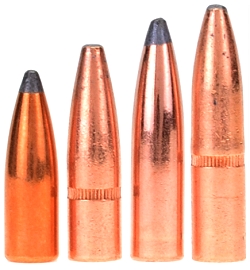
Any of the above can effectively kill medium to large game. Let’s call that kill range coyote to moose, with even the lightest bullet an excellent choice for deer. Pictured above from left to right –
Sierra Pro-Hunter #1900 120 grain flat base soft point: Recommended by Sierra for deer and antelope at 7mm-08 and 7x57mm velocities and considered a long range varmint bullet at magnum velocity. Sierra lists this bullet for target work due to its reputation for accuracy. 29 cents/ea typical.
Remington Core-Lokt #22754 140 grain protected point flat base: Recommended by Remington for deer size game and loaded in everything from the 7mm-08 Remington and 7x57mm to the 7mm Remington Magnum. The flat base preserves case capacity, the protected tip protects the bullet in handling and the cannelure makes for a durable assembly. 23 cents/ea typical.
Speer Hot Cor #1635160 grain flat base soft point is a tough, tapered jacket bullet with more than enough strength for deer or moose and similar size game like elk that might be hunted on other states. 21 cents/ea typical.
Remington Core-Lokt #22919 175 grain protected point, flat base is a very tough jacketed, deep penetrating bullet that would surely work on deer and black bear, but is more appropriately used for elk and moose. Like the 140 grain version, its tip is protected from handling damage and its cannelure groove makes for a durable assembly. 26 cents/ea typical.
Yes, there are bullets priced two to three times as much that suggest they are better, luring consumers with bright poly tips, radial… rings or driving bands and labeled with some pretty meaningful and/or threatening name. Unfortunately, wildlife can’t read marketing brochures or ballistic tables and the traditional bullets noted have consistently resulted in one shot kills and accurate shot placement.
Other stuff to fill the case…
I’ve working with three brands of 7x57mm brass, some recovered from factory ammo. The longest lasting has been Norma USA with a cost of approximately $1.07/ea. By comparison, Nosler is approximately $1.76. Remington brass is only 53 cents, but don’t hold your breath waiting for it to be in stock. A more creative way to brass is to purchase Sellier & Bellot loaded ammunition for 90 cents/ea or PPU ammunition for $1/ea and reload the brass. Remington large rifle primers were used for all of the loads that follow. Powder selected was best on hand, meaning best track record for a balance of power and accuracy.
Pressure
Modern cartridges are loaded to a wide spread of pressure levels. The ceilings have little to do with brass as brass is no more than a gasket sealing a breech face to chamber and, if left unsupported would blow out at not much more than 10,000 psi. So maximum chamber pressures are tied to the strength of steel supporting brass. The strength of the action might be defined by measuring an action’s lug shear strength, the amount of bolt thrust it can handle and the effects of bolt flex. It is common to hear the terms referenced, but usually not by anyone who has the knowledge and equipment to make them meaningful. And, no, I am certainly not a beacon of enlightenment in this regard.
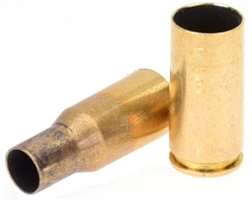 I do tend to use comparative data to to uncover potential. As an example, The Ruger Model 77 Hawkeye is chambered for the 7mm-08 Remington. With an operating pressure just a tick over 60,000 psi, the 7mm-08 Remington generates approximately 6985 lbs of bolt thrust. By comparison, the 7×57 Mauser, at a U.S. maximum pressure of 51,000 psi generates approximately 5336 lbs of bolt thrust. Raising the pressure of the 7×57 Mauser to 60,000 psi, consistent with the 7mm-08 Remington, the 7×57 Mauser generates approximately 6276 lbs of bolt thrust, or roughly 700 lbs less than the 7mm-08 Remington. The reduction is based on the interior case head surface, the surface parallel to the breech face, being smaller than that of the 7mm-08 Remington; 0.365″ compared to 0.385″. You can’t really arrive at bolt thrust by measuring the outside diameter of a case head, but it is easy enough to section a case and measure the diameter inside the radius of the case web.
I do tend to use comparative data to to uncover potential. As an example, The Ruger Model 77 Hawkeye is chambered for the 7mm-08 Remington. With an operating pressure just a tick over 60,000 psi, the 7mm-08 Remington generates approximately 6985 lbs of bolt thrust. By comparison, the 7×57 Mauser, at a U.S. maximum pressure of 51,000 psi generates approximately 5336 lbs of bolt thrust. Raising the pressure of the 7×57 Mauser to 60,000 psi, consistent with the 7mm-08 Remington, the 7×57 Mauser generates approximately 6276 lbs of bolt thrust, or roughly 700 lbs less than the 7mm-08 Remington. The reduction is based on the interior case head surface, the surface parallel to the breech face, being smaller than that of the 7mm-08 Remington; 0.365″ compared to 0.385″. You can’t really arrive at bolt thrust by measuring the outside diameter of a case head, but it is easy enough to section a case and measure the diameter inside the radius of the case web.
The diameter of the 7×57 Mauser’s shoulder is 0.430″, the 7mm-08 Remington shoulder diameter is 0.454″ which means an increased wall thickness for the Mauser cartridges. On the other hand, the Mauser has greater case taper, which reduces the case’s grip on the chamber wall, which plays to higher, although probably not significant, bolt thrust. So with heavy dose of anecdotal evidence and empirical data. I felt confidant enough to incrementally sneak up on 7×57 Mauser handloads loaded to 7mm-08 Remington pressure levels, stopping at the first sign of excessive pressure; tight turning bolt, tattooed case head, flat primers, leaking primers, case splits or radial fractures, or a gun barrel that takes on the appearance of a peeled banana.
Why bother with effort and not just get a 7mm-08 Remington chambered rifle? Because the 7×57 Mauser case hold more powder and has a longer neck, which combined offer higher velocity and greater accuracy and because I can. My fascination with firearms resides in what they could do when finessed and the satisfaction that comes from hunting with a personalized firearm and cartridge. My objective is to have a light, carbine length full stock that will not be punishing to shoot, but can efficiently down any game animal in Maine.
Factory Ammunition Baseline…
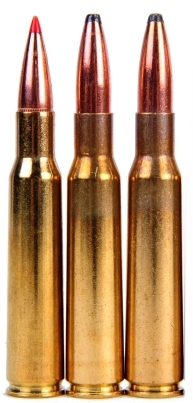
|
Factory Cartridges |
Bullet Grains |
Rated MV FPS |
Actual 22″ BBL MV FPS |
Actual 18.5″ BBL MV FPS |
| Hornady Superformance | 139 | 2760 | 2759 | 2548 |
| Prvi Partizan | 139 | 2657 | 2666 | 2495 |
| Prvi Partizan Thunder | 158 | 2460 | 2518 | 2331 |
Cartridge velocity are effected by barrel lengths. In this case, the change is significant. Pure speculation based on other experience, but I believe lower pressure cartridge are more effective when barrels are shortened as they need to pressure persistence to generate substantial velocity. This data was gathered at 22°F, factory and handloads, with fresh, pocket warmed batteries in the chronograph and the rifle shot to maintain a 70°F hardware temperature.
While the emphasis may seem to be velocity, that actually is not the case. Shooting through an 8x scope, factory ammo 3 shot groups fell comfortably inside one inch at 100 yards. At least this level of accuracy was required for handloads to be considered satisfactory and to continue development. I believe I have moved beyond my early days of handloading where velocity was everything and accuracy loss ended in a prayer for bigger deer.These days, accuracy is required. It either falls into place with rifle and handload tuning or the combination does not stay in my possession very long.
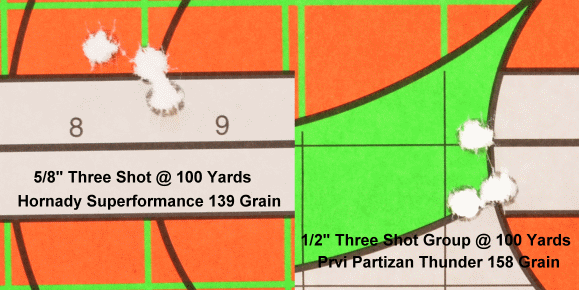
For folks who don’t think short barrel rifles can be accurate, or that handloading is necessary to achieve accuracy, left is the worst group shot with factory ammo, right, the best group shot with factory ammo.
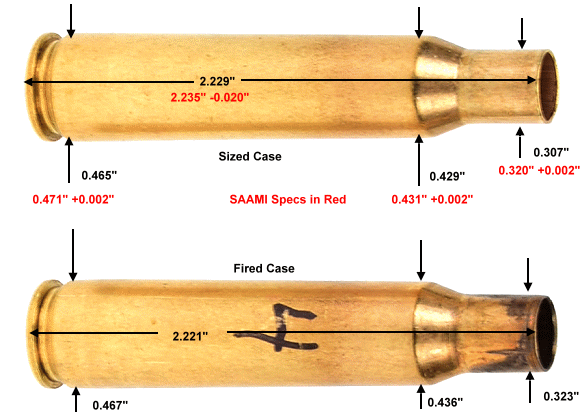
Above, the sized case was how the new brass measured leaving the die. The expander ball was removed to maximize neck tension, so the neck diameter is well under. The red dimensions represent the SAAMI spec for the 7×57 Mauser. The fired case indicated typical dimensions after first firing at the indicated pressures
Final Handloads
Warning: Handloads below are loaded to 7mm-08 Remington pressure levels of approximately 60,000 psi. Not safe for use in MilSurp and older sporting firearms elaborate with bolt thrust comparison between 7mm Mauser and 7mm-08. These are maximum loads in my workup. If you decide you understand the premise, and wish to try working up similar loads in similar firearms, I strongly suggest backing off 5% and working up carefully.
|
Cartridge: 7×57 Mauser |
|
| Firearm: Ruger Hawkeye International |
COL: 2.850″ – 3.065″ |
| Bullet Diameter: 0.2845″ -0.0030″/+0.0000″ | Primer: Remington 9 1/2 |
| Barrel: 18.5″ | Reloading Dies: Lee Precision |
| Case length: 02.235″ +0.000″/-0.020″ | Groups: 3 Shots 100 Yards |
| Bullet | Bullet Type |
Bullet Grains |
C.O.L.” | Powder Type |
Charge Grains |
Muzzle Velocity FPS |
Muzzle Energy Ft-Lbs |
100 Yard 3 Shot Group “ |
| Sierra Pro-Hunter | SPFB | 120 | 2.985 | H 414 | 54.0 | 2950 | 2319 | 0.7 |
| Sierra Pro-Hunter | SPFB | 120 | 2.985 | Re 17 | 55.0 | 3081 | 2530 | 0.3 |
| Remington Core-Lokt | PPFB | 140 | 2.965 | H414 | 51.5 | 2814 | 2462 | 0.9 |
| Remington Core-Lokt | PPFB | 140 | 2.965 | Re 17 | 51.5 | 2861 | 2545 | 0.5 |
| Speer Hot Cor | SPFB | 160 | 3.000 | H414 | 48.5 | 2635 | 2467 | 0.8 |
| Speer Hot Cor | SPFB | 160 | 3.000 | Re 17 | 48.5 | 2675 | 2543 | 0.6 |
| Remington Core-Lokt | PPFB | 175 | 3.000 | H414 | 47.0 | 2539 | 2506 | 0.9 |
| Remington Core-Lokt | PPFB | 175 | 3.000 | Re 17 | 47.0 | 2573 | 2573 | 0.8 |
The 120 and 140 grain loads were lightly compressed, the rest would qualify as case full with seated bullet. There were no hard extractions, there was no pressure damaged brass or telltale primer excessive pressure signs, but these are my final loads and there is no intention to press further with the expectation of diminishing returns.
Seven Millimeter Magic
| 120 Grain | ||||||||||||
| Yards | 0 | 50 | 100 | 150 | 200 | 250 | 300 | |||||
| Velocity – fps | 3081 | 2933 | 2790 | 2650 | 2515 | 2385 | 2258 | |||||
| Energy – ft.-lbs. | 2529 | 2292 | 2073 | 1871 | 1686 | 1515 | 1358 | |||||
| Momentum – lbs-sec | 53 | 50 | 48 | 45 | 43 | 41 | 39 | |||||
| Path – in. | -1.50 | 0.50 | 1.49 | 1.36 | 0.00 | -2.74 | -7.01 | |||||
| 175 Grain | ||||||||||||
| Yards | 0 | 50 | 100 | 150 | 200 | 250 | 300 | |||||
| Velocity – fps | 2573 | 2473 | 2375 | 2279 | 2186 | 2095 | 2006 | |||||
| Energy – ft.-lbs. | 2572 | 2375 | 2191 | 2018 | 1856 | 1705 | 1564 | |||||
| Momentum – lbs-sec | 64 | 62 | 59 | 57 | 55 | 52 | 50 | |||||
| Path – in. | -1.50 | 1.13 | 2.34 | 2.01 | -0.00 | -3.83 | -9.63 | |||||
Not bad for an 18.5″ barrel, 6 1/2 Lb rifle. Over 225 yards point blank range on a 6″ target and easy, minor hold over out to 300. The 175 grain bullets very high momentum numbers indicate why the 7mm works on even heavy body game and offers deep penetration. I’m happy and I’ve got a new favorite rifle.
Conclusion
I really love this rifle; the way it handles, the way it shoots and the way it looks. Let me be the first to say rifle preferences can be quantified and qualified, but they are ultimately subjective. In this case, I couldn’t think of a better Maine deer and black bear rifle. It will join a small, but select group of other rifles.

Email Notification